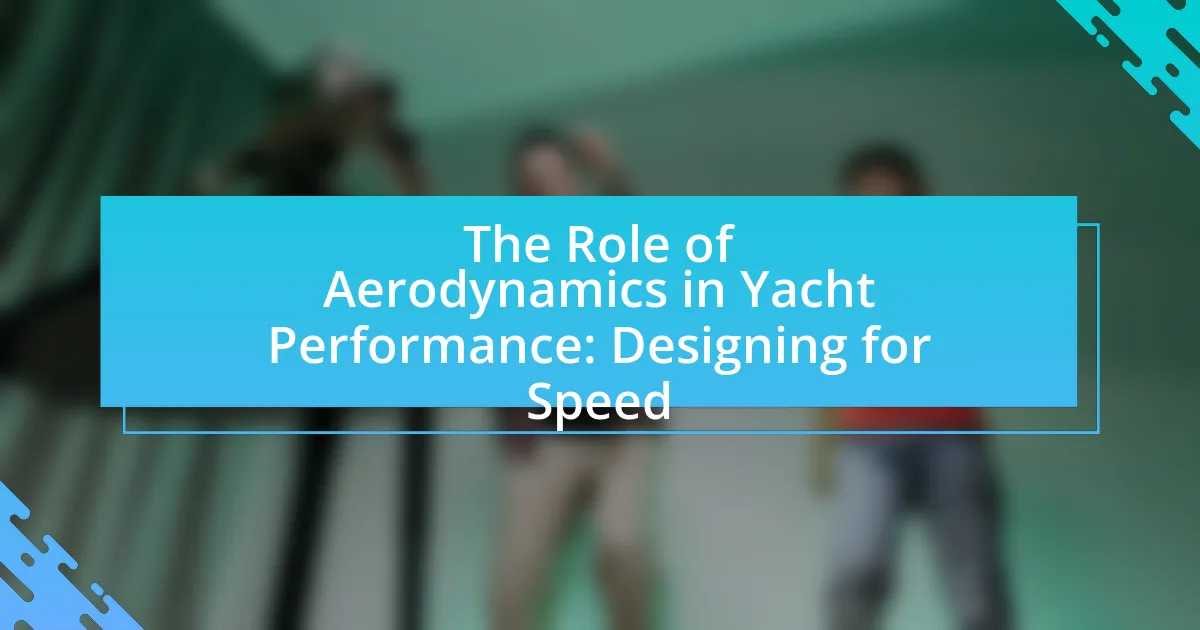The article focuses on the evolution of hull designs in yachting, highlighting the transition from traditional wooden boats to modern, hydrodynamic structures made from advanced materials. It examines how historical factors, technological advancements, and environmental considerations have influenced hull design, emphasizing the importance of stability and performance. Key innovations, such as computer-aided design and the use of lightweight composites, are discussed, along with the impact of user feedback on design improvements. The article also addresses the implications of different hull shapes and materials on sailing performance and maintenance, providing insights for yacht owners on optimizing their vessels for better stability and efficiency.

What is the Evolution of Hull Designs in Yachting?
The evolution of hull designs in yachting has progressed from simple, flat-bottomed wooden boats to sophisticated, hydrodynamic shapes made from advanced materials. Early hulls, such as those used by the Vikings, were designed for stability and speed in rough waters, featuring a long, narrow shape that allowed for efficient movement. As technology advanced, the introduction of fiberglass in the mid-20th century revolutionized hull construction, enabling lighter and more durable designs.
In recent decades, computer-aided design (CAD) and fluid dynamics simulations have further refined hull shapes, optimizing them for performance and stability. Modern yachts often feature multi-hull designs, such as catamarans and trimarans, which provide increased stability and reduced drag. The shift towards eco-friendly materials and designs, such as those incorporating renewable energy sources, also reflects the ongoing evolution in hull design, emphasizing both performance and sustainability.
How have hull designs changed over the years?
Hull designs have evolved significantly over the years, transitioning from traditional flat-bottomed shapes to more complex, hydrodynamic forms. Early hulls, primarily used in wooden boats, were designed for stability and ease of construction, while modern designs incorporate advanced materials and computer-aided design to enhance performance and efficiency. For instance, the introduction of multi-hull designs, such as catamarans and trimarans, has improved speed and stability, allowing for better handling in various sea conditions. Additionally, the use of materials like fiberglass and carbon fiber has reduced weight and increased durability, further influencing hull shape and performance. Historical advancements, such as the shift from displacement to planing hulls in the mid-20th century, demonstrate a clear trend towards optimizing speed and maneuverability in yacht design.
What historical factors influenced early hull designs?
Early hull designs were influenced by practical needs such as navigation, trade, and warfare. The development of maritime trade routes in ancient civilizations, like the Phoenicians and Greeks, necessitated hulls that could withstand rough seas and carry cargo efficiently. Additionally, advancements in shipbuilding techniques, such as the introduction of the keel for stability and the use of different materials like wood and later iron, shaped the evolution of hull forms. Historical evidence shows that Viking longships, with their shallow drafts and clinker-built designs, were optimized for both speed and versatility in coastal and riverine environments, reflecting the specific demands of their time.
How did technological advancements impact hull design evolution?
Technological advancements significantly influenced hull design evolution by enabling the development of more efficient shapes and materials. Innovations such as computer-aided design (CAD) and computational fluid dynamics (CFD) allowed designers to simulate and analyze hull performance in various conditions, leading to optimized designs that reduce drag and improve stability. For instance, the introduction of lightweight composite materials has allowed for stronger and more hydrodynamic hulls, enhancing speed and fuel efficiency. Additionally, advancements in manufacturing techniques, such as 3D printing, have facilitated the creation of complex hull geometries that were previously difficult to achieve, further pushing the boundaries of yacht design.
Why is hull design critical for yacht stability?
Hull design is critical for yacht stability because it directly influences the vessel’s center of gravity and buoyancy. A well-designed hull ensures that the yacht remains upright and balanced in various sea conditions, reducing the risk of capsizing. For instance, a wider beam increases stability by lowering the center of gravity, while a deeper keel enhances resistance to lateral forces. Research indicates that hull shapes, such as the modern fin keel and bulbous bow, have evolved to optimize hydrodynamic efficiency and stability, demonstrating the importance of design in maintaining safety and performance at sea.
What role does hull shape play in stability?
Hull shape significantly influences a vessel’s stability by affecting its center of gravity and buoyancy. A wider hull typically provides greater initial stability, as it increases the vessel’s resistance to heeling. Conversely, a narrow hull can enhance speed but may compromise stability, particularly in rough waters. Research indicates that hull designs with a deeper V-shape improve performance in waves by allowing for better water displacement, thus maintaining stability during navigation. For example, the design of modern racing yachts often incorporates these principles, balancing speed and stability to optimize performance.
How do different materials affect hull stability?
Different materials significantly affect hull stability by influencing weight distribution, buoyancy, and structural integrity. For instance, fiberglass is lightweight and offers good buoyancy, which enhances stability in calm waters, while steel provides greater strength and durability, making it suitable for rougher conditions. Additionally, aluminum hulls are known for their rigidity and resistance to corrosion, contributing to overall stability. Research indicates that hulls made from composite materials can optimize weight and strength, leading to improved performance and stability in various sea conditions.
What innovations are currently shaping hull designs?
Innovations currently shaping hull designs include the use of advanced materials, hydrodynamic optimization, and computer-aided design technologies. Advanced materials such as carbon fiber and composite materials enhance strength while reducing weight, improving overall performance and fuel efficiency. Hydrodynamic optimization techniques, including computational fluid dynamics (CFD), allow designers to create hull shapes that minimize drag and maximize stability in various sea conditions. Additionally, computer-aided design technologies enable rapid prototyping and testing of new designs, leading to more efficient and innovative hull structures. These innovations collectively contribute to enhanced yacht stability and performance in the marine environment.
Which modern technologies are being integrated into hull designs?
Modern technologies integrated into hull designs include computational fluid dynamics (CFD), advanced materials like carbon fiber and composites, and automated manufacturing techniques such as 3D printing. CFD allows for precise modeling of water flow around the hull, enhancing hydrodynamic efficiency. The use of carbon fiber and composites reduces weight while increasing strength and durability, which is crucial for performance and longevity. Additionally, 3D printing enables the creation of complex shapes and structures that were previously difficult or impossible to achieve, allowing for innovative design solutions that improve stability and performance.
How are designers addressing stability challenges with new designs?
Designers are addressing stability challenges in new yacht designs by incorporating advanced hull shapes and materials that enhance hydrodynamic performance. For instance, the use of computer-aided design (CAD) allows for precise modeling of hull forms, which can be optimized for better stability in various sea conditions. Additionally, the integration of features such as wider beams and dual hulls has been shown to improve stability by lowering the center of gravity and increasing resistance to capsizing. Research indicates that yachts with these innovative designs can experience up to 30% less roll in rough waters, demonstrating the effectiveness of these approaches in enhancing stability.

What are the Key Factors Influencing Hull Design Innovations?
Key factors influencing hull design innovations include advancements in materials, hydrodynamic efficiency, regulatory standards, and technological integration. Advancements in materials, such as lightweight composites and high-strength alloys, enable designers to create more efficient and durable hulls. Hydrodynamic efficiency is crucial for improving speed and fuel efficiency, leading to innovations in hull shapes and designs. Regulatory standards, including environmental regulations and safety requirements, drive the need for innovative designs that comply with new laws. Technological integration, such as computer-aided design (CAD) and simulation tools, allows for more precise modeling and testing of hull designs, resulting in enhanced performance and stability.
How does hydrodynamics affect hull design?
Hydrodynamics significantly influences hull design by determining how water flows around a vessel, impacting its speed, stability, and fuel efficiency. The shape and contour of a hull are optimized based on hydrodynamic principles to minimize resistance and enhance performance in various sea conditions. For instance, streamlined hulls reduce drag, allowing for faster travel and better fuel economy, while specific designs, such as deep-V or flat-bottom hulls, cater to different stability needs and operational purposes. Research has shown that hulls designed with hydrodynamic considerations can improve fuel efficiency by up to 20%, demonstrating the critical role of hydrodynamics in modern yacht design.
What principles of hydrodynamics are most relevant to yacht stability?
The principles of hydrodynamics most relevant to yacht stability include buoyancy, center of gravity, and hydrodynamic resistance. Buoyancy ensures that the yacht remains afloat by counteracting its weight, while the center of gravity affects how the yacht responds to external forces, influencing its stability. Hydrodynamic resistance, which encompasses drag and lift forces acting on the hull, plays a crucial role in maintaining balance and preventing capsizing. These principles are foundational in yacht design, as they dictate how hull shapes and materials are optimized for stability in various sea conditions.
How do designers test hydrodynamic efficiency?
Designers test hydrodynamic efficiency primarily through computational fluid dynamics (CFD) simulations and physical model testing in towing tanks. CFD allows designers to analyze fluid flow around hull shapes, providing insights into drag and lift characteristics, while towing tank tests involve scaling down the yacht design to measure resistance and performance in controlled water conditions. These methods are validated by comparing simulation results with empirical data from model tests, ensuring accuracy in predicting the hydrodynamic behavior of full-scale vessels.
What environmental considerations are impacting hull design?
Environmental considerations impacting hull design include fuel efficiency, emissions reduction, and the effects of climate change on marine ecosystems. Designers are increasingly focused on creating hulls that minimize drag to enhance fuel efficiency, which directly reduces greenhouse gas emissions. Additionally, regulations such as the International Maritime Organization’s MARPOL Annex VI set limits on sulfur oxides and nitrogen oxides, prompting innovations in hull shapes and materials to comply with these standards. Furthermore, climate change is altering sea conditions, necessitating hull designs that can withstand more extreme weather and improve stability, ensuring safety and performance in varying marine environments.
How are sustainability practices influencing material choices?
Sustainability practices are significantly influencing material choices in yacht design by prioritizing eco-friendly and renewable materials. Designers are increasingly opting for materials such as recycled aluminum, sustainable wood, and bio-composites, which reduce environmental impact and enhance the lifecycle of the vessels. For instance, the use of recycled aluminum can lower energy consumption during production by up to 95% compared to new aluminum, demonstrating a clear benefit in sustainability. Additionally, the adoption of bio-composites, which are derived from natural fibers and resins, not only minimizes reliance on fossil fuels but also offers improved performance characteristics, such as weight reduction and strength. This shift towards sustainable materials reflects a broader industry trend aimed at reducing carbon footprints and promoting environmental stewardship in yacht manufacturing.
What regulations are shaping the future of hull designs?
Regulations shaping the future of hull designs include the International Maritime Organization’s (IMO) Energy Efficiency Design Index (EEDI) and the International Convention for the Control and Management of Ships’ Ballast Water and Sediments. The EEDI mandates that new ships meet specific energy efficiency standards, influencing hull shape and materials to reduce resistance and improve fuel efficiency. The ballast water convention requires designs that minimize the risk of invasive species transfer, prompting innovations in hull designs that facilitate easier management of ballast systems. These regulations drive advancements in hydrodynamics and eco-friendly materials, ensuring that future hull designs are not only efficient but also environmentally sustainable.
What role does user feedback play in hull design evolution?
User feedback plays a crucial role in hull design evolution by providing insights into performance, comfort, and safety from actual users. This feedback informs designers about specific issues such as stability in various sea conditions, user preferences for speed and maneuverability, and overall satisfaction with the vessel’s handling. For instance, the incorporation of user feedback has led to significant design changes in hull shapes, resulting in improved hydrodynamics and fuel efficiency. Historical examples include the transition from traditional displacement hulls to more modern planing hulls, driven by sailor input on performance needs. This iterative process ensures that hull designs not only meet technical specifications but also align with user expectations and real-world usage scenarios.
How do sailors’ experiences inform design improvements?
Sailors’ experiences inform design improvements by providing practical insights into vessel performance and safety. Their feedback on aspects such as stability, maneuverability, and comfort directly influences the iterative design process of hulls. For instance, sailors often report on how different hull shapes perform in various sea conditions, leading designers to refine features like the keel and beam width to enhance stability. Historical data shows that modifications based on sailor input, such as the introduction of bulb keels, have significantly improved yacht performance in rough waters, demonstrating the critical role of firsthand experience in driving innovation in yacht design.
What methods are used to gather user feedback on hull performance?
User feedback on hull performance is gathered through various methods including surveys, interviews, and performance monitoring systems. Surveys are often distributed to yacht owners and operators to collect quantitative data on their experiences and satisfaction levels. Interviews provide qualitative insights, allowing users to share detailed feedback about specific aspects of hull performance. Additionally, performance monitoring systems utilize sensors and data analytics to track real-time performance metrics, enabling a more objective assessment of hull efficiency and stability. These methods collectively ensure a comprehensive understanding of user experiences and preferences regarding hull designs.

How Can Yacht Owners Benefit from Understanding Hull Design Innovations?
Yacht owners can benefit from understanding hull design innovations by enhancing their vessel’s performance, safety, and fuel efficiency. Innovations in hull design, such as the use of hydrodynamic shapes and materials, lead to improved stability and reduced drag, which directly affects speed and handling. For instance, modern hull designs often incorporate features like bulbous bows and multi-hull configurations that significantly enhance stability in rough waters. Research indicates that yachts with advanced hull designs can achieve up to 30% better fuel efficiency compared to traditional designs, making them more economical to operate. Understanding these innovations allows yacht owners to make informed decisions about purchasing, upgrading, or maintaining their vessels, ultimately leading to a better overall yachting experience.
What should yacht owners consider when choosing a hull design?
Yacht owners should consider the intended use of the yacht, as different hull designs offer varying performance characteristics. For example, a deep-V hull provides better stability and handling in rough waters, making it suitable for offshore cruising, while a flat-bottom hull offers shallow draft and is ideal for calm, inland waters. Additionally, the material of the hull, such as fiberglass or aluminum, affects durability and maintenance requirements. Research indicates that hull shape influences hydrodynamics, impacting speed and fuel efficiency; for instance, a streamlined hull can reduce drag, enhancing performance. Therefore, understanding these factors is crucial for yacht owners to select a hull design that aligns with their specific needs and preferences.
How do different hull shapes affect sailing performance?
Different hull shapes significantly affect sailing performance by influencing speed, stability, and maneuverability. For instance, a narrow hull shape, like that of a racing yacht, reduces water resistance and allows for higher speeds, while a wider hull provides greater stability, making it suitable for cruising. Research indicates that hull designs with a deeper V-shape enhance performance in rough waters by cutting through waves more effectively, as demonstrated by the success of modern offshore racing yachts. Conversely, flat-bottomed hulls are better for shallow waters and offer increased stability at lower speeds, which is beneficial for recreational sailing. Thus, the choice of hull shape directly correlates with the intended use and sailing conditions, impacting overall performance.
What are the maintenance implications of various hull materials?
The maintenance implications of various hull materials vary significantly based on their properties. Fiberglass hulls require regular inspections for stress cracks and osmosis, necessitating periodic sanding and reapplication of gel coat to maintain integrity. Aluminum hulls, while lightweight and resistant to corrosion, demand vigilant monitoring for galvanic corrosion, often requiring protective coatings and regular cleaning to prevent oxidation. Steel hulls, known for their durability, require consistent maintenance to prevent rust, including regular painting and inspections for structural integrity. Wood hulls, although aesthetically pleasing, necessitate the most intensive maintenance, including regular sealing, varnishing, and inspections for rot and insect damage. Each material’s unique characteristics dictate specific maintenance routines to ensure longevity and performance.
What best practices can enhance yacht stability based on hull design?
To enhance yacht stability based on hull design, incorporating a wider beam is essential, as it lowers the center of gravity and increases resistance to heeling. Additionally, utilizing a deep-V hull shape improves stability by allowing the yacht to cut through waves more effectively, reducing rolling motion. The inclusion of bilge keels can further enhance stability by providing lateral resistance and minimizing sideways drift. Research indicates that yachts designed with these features demonstrate improved performance in rough waters, as evidenced by studies conducted by the American Bureau of Shipping, which highlight the correlation between hull design and stability metrics.
How can owners optimize their yacht’s performance through design awareness?
Owners can optimize their yacht’s performance through design awareness by understanding the impact of hull shape, materials, and weight distribution on stability and speed. For instance, a streamlined hull design reduces drag, enhancing fuel efficiency and speed, while lightweight materials like carbon fiber improve overall performance. Additionally, proper weight distribution ensures better balance and maneuverability, which is crucial for stability in various sea conditions. Research indicates that modern hull designs, such as the use of multi-hulls, can significantly increase stability and reduce heeling, further optimizing performance.
What common mistakes should yacht owners avoid regarding hull design?
Yacht owners should avoid neglecting the importance of hull shape and material selection in their designs. A poorly designed hull can lead to reduced stability, increased drag, and compromised performance. For instance, using a hull shape that is not optimized for the intended use, such as a deep-V hull for cruising instead of a planing hull, can result in inefficient fuel consumption and poor handling. Additionally, selecting inappropriate materials, like using heavy materials instead of lightweight composites, can adversely affect speed and maneuverability. These design oversights can significantly impact the yacht’s overall functionality and safety on the water.

















